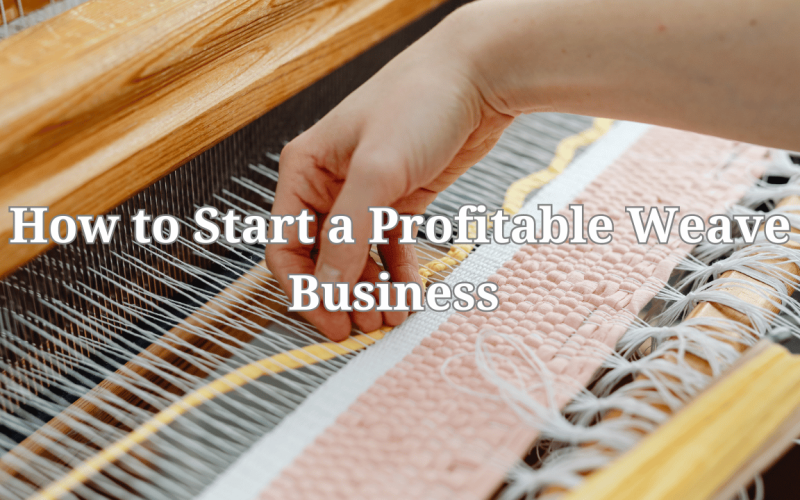You’ve come to the correct place if you love weaving and want to make it into a successful company.
Weaves refer to hair extensions that women attach to their heads, typically through sewing or gluing, while wigs are pre-styled weaves that women wear like a cap on their heads.
Among the various beauty business concepts available, starting a wig and weave business can be initiated with low-cost capital.
This guide will explain a step-by-step process for starting a wig weave business and outline.
How to Start a Profitable Weave Business
The beginning of a weaving company can be exciting and rewarding.
However, success does not come easily. You must take the right steps to build a solid business foundation.
The following are some essential steps to follow to succeed in the weaving sector:
1. Do your research
To assist you in making wise judgments, identify your target market and competitors.
Conducting market research involves several approaches, such as:
- perusing magazines focused on retailing wigs and weaves,
- observing advertisements related to these products,
- participating in beauty expos, analyzing your competitors, and
- conversing with friends and colleagues who have an affinity for wigs and weaves.
Read Also: 10 Best Accounting Software for Architects and Architecture Firms
Emerging trends, competition listings, pricing plans for wigs and weaves, demographics of your target market, and product preferences are just a few of the items that should be included in your research.
2. Define Your Product
Now that you have comprehensively understood the market, your next action is to determine the specific types of wigs and weaves you intend to launch.
Wigs and weaves can be distinguished based on various factors, including color, length, texture, and the materials used (such as human hair, kanekalon, or synthetic materials).
Discover what consumers are seeking, the price points they are willing to accept, the various categories of wigs and weaves available, the distinctions between them, the available lengths, and the proper care instructions for each hair type, as you will need to educate your customers.
Document all the insights you have gathered to compile a prospective product list, including pricing details and information on where to source these products inexpensively.
3. Source for your products
As a weave business owner, you must ensure your customers receive products of the highest caliber.
Look for trustworthy vendors who offer human hair extensions and other hair supplies.
Invest in high-quality weaves, ensuring you have readily available stock for customers seeking immediate purchases.
Your objective should be to identify wholesalers or manufacturers willing to provide you with products at discounted rates, ensuring that you can secure a minimum profit margin of at least 40% to cover your expenses and leave room for profitability.
Caution is advisable when considering online suppliers, as it’s challenging to assess the precise quality of wigs or weaves remotely.
If you believe you can find more cost-effective options online, perhaps from platforms like Aliexpress or Chinese retailers, you can follow this approach:
- Visit a wholesale market locally, inspect the products there,
- Take note of their specifics such as name, make, and brand features, and
- Then return to the online sphere to request the exact item from your chosen supplier.
Therefore, to initiate your venture, it’s advisable to establish a solid relationship with a local supplier who operates a physical store, allowing you to assess the quality and texture of the wigs personally.
Moreover, it’s advisable to negotiate terms with wholesalers or manufacturers that permit you to return unsold merchandise within a specified timeframe in exchange for different products.
4. Select a Business Location
You can establish a physical retail store, launch an e-commerce platform, or operate as a vendor at flea markets.
If you opt for an online business model without a physical storefront, you must also arrange for clean storage space.
Possibilities include renting a warehouse or a commercial storage facility, but you can also consider cost-effective alternatives such as a spare garage or closet equipped with airtight storage containers.
When storing human hair, it can be either hung up or laid flat, as long as it is not subjected to bending or twisting, preserving its quality.
5. Market Your Business
If you operate a brick-and-mortar store, establish a strong local presence by organizing or sponsoring events like hair shows, fashion exhibitions, or similar gatherings in your community.
Another impactful strategy is to contribute hair or supplies to create custom wigs for individuals coping with hair loss due to alopecia or cancer.
This brings personal fulfillment and opens the door to potential media coverage.
For those selling human hair products through online channels, actively engage with your audience by consistently updating your social media profiles.
Launch a blog offering valuable hair-styling tips or advertise your products on forums and websites frequented by your target customer base.
6. Decide on How to Deliver
Make plan on how best to deliver your good to customers especially if you launch an online store.
You can partner with local logistics company or register your business with international shipping companies.
Fedex and DHL are some popular but you can also carry out research on others that would be effective for your business.
Read Also: 10+ Best Accounting Software for Plumbers and Plumbing Businesses
7. Sell Supplementary Supplies
Increase your revenue by offering products commonly used for human hair weaving, such as bonding adhesives, brushes, hair razors, and weaving needles.
Chances are high that your customers will require these items, so why miss out on the opportunity to generate extra income?
Many human hair distributors also provide wholesale weaving supplies.
8. Offer Incentives
In a market with numerous beauty supply shops offering a wide range of human hair products, you must give people compelling reasons to choose your business over the competition.
Extend discounts to salon professionals and cosmetology students to secure loyal and repeat business.
These clients can be particularly valuable, and the savings you offer can easily be recouped as they tend to make larger hair purchases compared to regular customers.
The discount you provide should fall within the range of 20 percent to 35 percent off the retail price, depending on the prevailing standards in your locality.
What is the Average Cost to Start a Weave Business?
To estimate the required capital to start a Weave business you will need to:
1. Having a clear vision of your desired business model
Are you aiming for a fully online automated hair store, a blend of a physical store with a salon and an online presence, or a salon with or without staff?
Each of these options comes with its unique startup costs.
If your business necessitates a physical building for a store or salon, you must factor in expenses related to financing or rent.
However, if you’re venturing into an online store, the initial investment could be as low as $600.
The majority of these funds will be allocated to web hosting services, the platforms you utilize, and purchasing hair extensions.
2. Consider your expenses
It’s also crucial to consider various expenses beyond inventory, stationery, and marketing.
You’ll need to account for the business’s cost during the initial months. Some of these expenditures are one-time fees, like the cost of business incorporation or signage for your establishment.
Others are ongoing, covering utilities, inventory restocking, insurance, and more.
3. Rainy day funds
It’s prudent to err on the side of caution and allocate extra funds for unexpected expenses.
Unforeseen costs tend to arise in business operations, so it’s wise to be prepared.
Your expenses can be categorized into two main groups: fixed and variable.
Fixed expenses encompass rent, utilities, administrative overhead, and insurance premiums.
Variable expenses encompass inventory replenishment, shipping and packaging expenses, sales commissions, and other costs directly tied to the sale of hair products.
The scale of your hair extension business will influence these costs, either increasing or decreasing them accordingly.
Conclusion
Starting a profitable weave business is achievable with the right knowledge and planning.
Remember to budget effectively and consider all the costs of running a weave business every month.
Alternatively, you can adopt a dropshipping approach if you have no capital.
With drop shipping, you take customer orders, and they make payments before delivery.
Subsequently, you use these funds to purchase the products from the supplier, ensuring you retain your profit margin.






![How To Start A Curtain Business - [Complete Guide]](https://www.saharamagnate.com/wp-content/uploads/2023/05/How-To-Start-A-Curtain-Business-380x220.png)